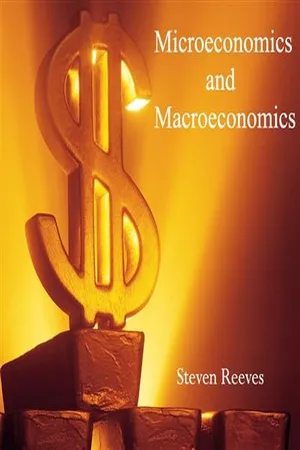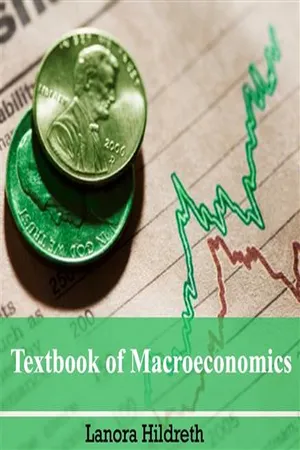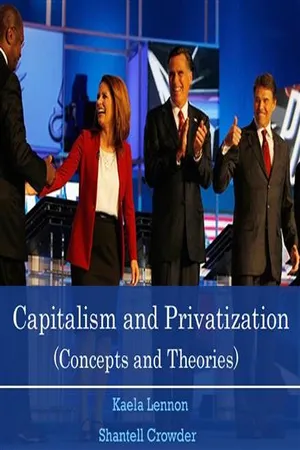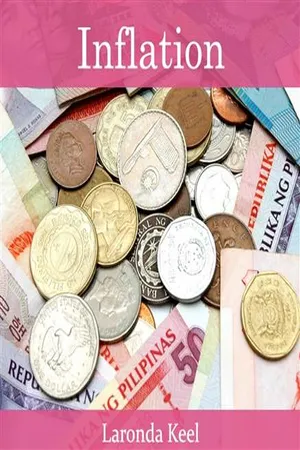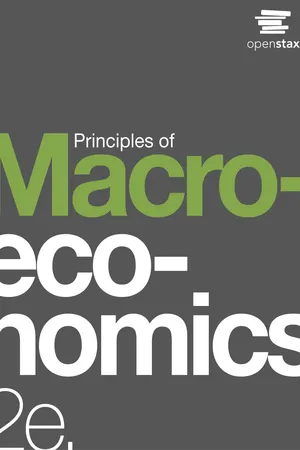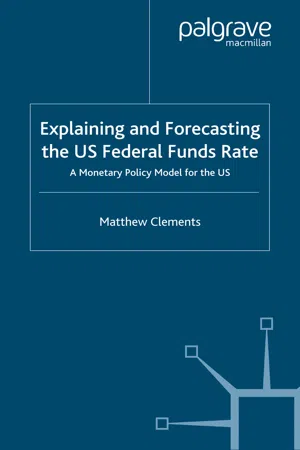Economics
Monetary Policy
Monetary policy refers to the actions taken by a country's central bank to manage the money supply and interest rates in order to achieve specific economic goals, such as controlling inflation or promoting economic growth. This is typically done through measures like adjusting interest rates, open market operations, and setting reserve requirements for banks.
Written by Perlego with AI-assistance
Related key terms
1 of 5
11 Key excerpts on "Monetary Policy"
- No longer available |Learn more
- (Author)
- 2014(Publication Date)
- Orange Apple(Publisher)
Various states in the United States have various forms of self-imposed fiscal straitjackets. Monetary Policy Monetary Policy is the process by which the monetary authority of a country controls the supply of money, often targeting a rate of interest to attain a set of objectives oriented towards the growth and stability of the economy. These goals usually include relatively stable prices and low unemployment. Monetary theory provides insight into how to craft optimal Monetary Policy. Monetary Policy is referred to as either being an expansionary policy, or a contractionary policy, where an expansionary policy increases the total supply of money in the economy rapidly, and a contractionary policy decreases the total money supply, or increases it slowly. Expansionary policy is traditionally used to combat unemployment in a recession by lowering interest rates, while contractionary policy involves raising interest rates to combat inflation. Monetary Policy is contrasted with fiscal policy, which refers to government borrowing, spending and taxation. Overview Monetary Policy rests on the relationship between the rates of interest in an economy, that is, the price at which money can be borrowed, and the total supply of money. Monetary Policy uses a variety of tools to control one or both of these, to influence outcomes like economic growth, inflation, exchange rates with other currencies and unemployment. Where currency is under a monopoly of issuance, or where there is a regulated system of issuing currency through banks which are tied to a central bank, the monetary authority has the ability to alter the money supply and thus influence the interest rate (to achieve policy goals). The beginning of Monetary Policy as such comes from the late 19th century, where it was used to maintain the gold standard. A policy is referred to as contractionary if it reduces the size of the money supply or increases it only slowly, or if it raises the interest rate. - No longer available |Learn more
- (Author)
- 2014(Publication Date)
- Library Press(Publisher)
____________________ WORLDTECHNOLOGIES ____________________ Chapter- 4 Monetary Policy Monetary Policy is the process by which the monetary authority of a country controls the supply of money, often targeting a rate of interest for the purpose of promoting economic growth and stability. The official goals usually include relatively stable prices and low unemployment. Monetary theory provides insight into how to craft optimal Monetary Policy. Monetary Policy is referred to as either being expansionary or contractionary, where an expansionary policy increases the total supply of money in the economy more rapidly than usual, and contractionary policy expands the money supply more slowly than usual or even shrinks it. Expansionary policy is traditionally used to try to combat un-employment in a recession by lowering interest rates in the hope that easy credit will entice businesses into expanding. Contractionary policy is intended to slow inflation in hopes of avoiding the resulting distortions and deterioration of asset values. Monetary Policy differs from fiscal policy, which refers to taxation, government spending, and associated borrowing. Overview Monetary Policy rests on the relationship between the rates of interest in an economy, that is, the price at which money can be borrowed, and the total supply of money. Monetary Policy uses a variety of tools to control one or both of these, to influence outcomes like economic growth, inflation, exchange rates with other currencies and unemployment. Where currency is under a monopoly of issuance, or where there is a regulated system of issuing currency through banks which are tied to a central bank, the monetary authority has the ability to alter the money supply and thus influence the interest rate (to achieve policy goals). The beginning of Monetary Policy as such comes from the late 19th century, where it was used to maintain the gold standard. - No longer available |Learn more
- (Author)
- 2014(Publication Date)
- White Word Publications(Publisher)
____________________ WORLD TECHNOLOGIES ____________________ Chapter-8 Monetary Policy Monetary Policy is the process by which the monetary authority of a country controls the supply of money, often targeting a rate of interest for the purpose of promoting economic growth and stability. The official goals usually include relatively stable prices and low unemployment. Monetary theory provides insight into how to craft optimal Monetary Policy. Monetary Policy is referred to as either being expansionary, or a contractionary, where an expansionary policy increases the total supply of money in the economy more rapidly than usual, and a contractionary policy expands the money supply more slowly than usual or even shrinks it. Expansionary policy is traditionally used to try to combat unemplo-yment in a recession by lowering interest rates in the hope that easy credit will entice businesses into expanding. Contractionary policy is intended to slow inflation in hopes of avoiding the resulting distortions and deterioration of asset values. Monetary Policy is contrasted with fiscal policy, which refers to: taxation, government spending, and associated borrowing. Overview Monetary Policy rests on the relationship between the rates of interest in an economy, that is, the price at which money can be borrowed, and the total supply of money. Monetary Policy uses a variety of tools to control one or both of these, to influence outcomes like economic growth, inflation, exchange rates with other currencies and unemployment. Where currency is under a monopoly of issuance, or where there is a regulated system of issuing currency through banks which are tied to a central bank, the monetary authority has the ability to alter the money supply and thus influence the interest rate (to achieve policy goals). The beginning of Monetary Policy as such comes from the late 19th century, where it was used to maintain the gold standard. - No longer available |Learn more
- (Author)
- 2014(Publication Date)
- College Publishing House(Publisher)
____________________ WORLD TECHNOLOGIES ____________________ Chapter- 4 Monetary Policy Monetary Policy is the process by which the monetary authority of a country controls the supply of money, often targeting a rate of interest for the purpose of promoting economic growth and stability. The official goals usually include relatively stable prices and low unemployment. Monetary theory provides insight into how to craft optimal Monetary Policy. Monetary Policy is referred to as either being expansionary or contractionary, where an expansionary policy increases the total supply of money in the economy more rapidly than usual, and contractionary policy expands the money supply more slowly than usual or even shrinks it. Expansionary policy is traditionally used to try to combat unemployment in a recession by lowering interest rates in the hope that easy credit will entice businesses into expanding. Contractionary policy is intended to slow inflation in hopes of avoiding the resulting distortions and deterioration of asset values. Monetary Policy differs from fiscal policy, which refers to taxation, government spending, and associated borrowing. Overview Monetary Policy rests on the relationship between the rates of interest in an economy, that is, the price at which money can be borrowed, and the total supply of money. Monetary Policy uses a variety of tools to control one or both of these, to influence outcomes like economic growth, inflation, exchange rates with other currencies and unemployment. Where currency is under a monopoly of issuance, or where there is a regulated system of issuing currency through banks which are tied to a central bank, the monetary authority has the ability to alter the money supply and thus influence the interest rate (to achieve policy goals). The beginning of Monetary Policy as such comes from the late 19th century, where it was used to maintain the gold standard. - No longer available |Learn more
- (Author)
- 2014(Publication Date)
- Orange Apple(Publisher)
____________________ WORLD TECHNOLOGIES ____________________ Chapter- 6 Monetary Policy Monetary Policy is the process by which the monetary authority of a country controls the supply of money, often targeting a rate of interest to attain a set of objectives oriented towards the growth and stability of the economy. These goals usually include relatively stable prices and low unemployment. Monetary theory provides insight into how to craft optimal Monetary Policy. Monetary Policy is referred to as either being an expansionary policy, or a contractionary policy, where an expansionary policy increases the total supply of money in the economy rapidly, and a contractionary policy decreases the total money supply, or increases it slowly. Expansionary policy is traditionally used to combat unemployment in a recession by lowering interest rates, while contractionary policy involves raising interest rates to combat inflation. Monetary Policy is contrasted with fiscal policy, which refers to government borrowing, spending and taxation. Overview Monetary Policy rests on the relationship between the rates of interest in an economy, that is, the price at which money can be borrowed, and the total supply of money. Monetary Policy uses a variety of tools to control one or both of these, to influence outcomes like economic growth, inflation, exchange rates with other currencies and unemployment. Where currency is under a monopoly of issuance, or where there is a regulated system of issuing currency through banks which are tied to a central bank, the monetary authority has the ability to alter the money supply and thus influence the interest rate (to achieve policy goals). The beginning of Monetary Policy as such comes from the late 19th century, where it was used to maintain the gold standard. A policy is referred to as contractionary if it reduces the size of the money supply or increases it only slowly, or if it raises the interest rate. - eBook - PDF
- Steven A. Greenlaw, Timothy Taylor, David Shapiro(Authors)
- 2017(Publication Date)
- Openstax(Publisher)
Monetary Policy affects the economy only after a time lag that is typically long and of variable length. Remember, Monetary Policy involves a chain of events: the central bank must perceive a situation in the economy, hold a meeting, and make a decision to react by tightening or loosening Monetary Policy. The change in Monetary Policy must percolate through the banking system, changing the quantity of loans and affecting interest rates. When interest rates change, businesses must change their investment levels and consumers must change their borrowing patterns when purchasing homes or cars. Then it takes time for these changes to filter through the rest of the economy. As a result of this chain of events, Monetary Policy has little effect in the immediate future. Instead, its primary effects are felt perhaps one to three years in the future. The reality of long and variable time lags does not mean that a central bank should refuse to make decisions. It does mean that central banks should be humble about taking action, because of the risk that their actions can create as much or more economic instability as they resolve. Excess Reserves Banks are legally required to hold a minimum level of reserves, but no rule prohibits them from holding additional excess reserves above the legally mandated limit. For example, during a recession banks may be hesitant to lend, because they fear that when the economy is contracting, a high proportion of loan applicants become less likely to repay their loans. When many banks are choosing to hold excess reserves, expansionary Monetary Policy may not work well. This may occur because the banks are concerned about a deteriorating economy, while the central bank is trying to expand the money supply. If the banks prefer to hold excess reserves above the legally required level, the central bank cannot force individual banks to make loans. - eBook - PDF
- David Shapiro, Daniel MacDonald, Steven A. Greenlaw(Authors)
- 2022(Publication Date)
- Openstax(Publisher)
During the 2008-2009 recession, we can interpret the Fed's “quantitative easing” policies (discussed below) as a willingness to make short-term credit available as needed in a time when the banking and financial system was under stress. 15.3 How a Central Bank Executes Monetary Policy LEARNING OBJECTIVES By the end of this section, you will be able to: • Explain the reason for open market operations • Evaluate reserve requirements and discount rates • Interpret and show bank activity through balance sheets The Federal Reserve's most important function is to conduct the nation’s Monetary Policy. Article I, Section 8 of the U.S. Constitution gives Congress the power “to coin money” and “to regulate the value thereof.” As part of 15.3 • How a Central Bank Executes Monetary Policy 363 the 1913 legislation that created the Federal Reserve, Congress delegated these powers to the Fed. Monetary Policy involves managing interest rates and credit conditions, which influences the level of economic activity, as we describe in more detail below. A central bank has three traditional tools to implement Monetary Policy in the economy: • Open market operations • Changing reserve requirements • Changing the discount rate In discussing how these three tools work, it is useful to think of the central bank as a “bank for banks”—that is, each private-sector bank has its own account at the central bank. We will discuss each of these Monetary Policy tools in the sections below. Open Market Operations Since the early 1920s, the most common Monetary Policy tool in the U.S. has been open market operations. These take place when the central bank sells or buys U.S. Treasury bonds in order to influence the quantity of bank reserves and the level of interest rates. The specific interest rate targeted in open market operations is the federal funds rate. - eBook - PDF
Economics for Investment Decision Makers
Micro, Macro, and International Economics
- Christopher D. Piros, Jerald E. Pinto(Authors)
- 2013(Publication Date)
- Wiley(Publisher)
We demonstrated earlier how a central bank can manipulate the money supply and growth of the money supply. We also indicated how policy rates set and targeted by the central banks are usually very short- term in nature; often they target overnight interest rates. However, most businesses and individuals in the real economy borrow and lend over much longer time frames than this. It may not be obvious, then, how changing short-term interest rates can influence the real economy, particularly if money neutrality holds in the long run. The fact that central bankers believe that they can affect real economic variables, in particular economic growth, by influencing broad money growth suggests that they believe that money is not neutral—at least not in the short run. Exhibit 7-7 presents a stylized representation of the monetary transmission mechanism. This is the process whereby a central bank’s interest rate gets transmitted through the economy and ultimately affects the rate of increase of prices—that is, inflation. Suppose that a central bank announces an increase in its official interest rate. The implementation of the policy may begin to work through the economy via four interrelated channels. Those channels include bank lending rates, asset prices, agents’ expectations, and 356 Economics for Investment Decision Makers exchange rates. First, as described earlier, the base rates of commercial banks and interbank rates should rise in response to the increase in the official rate. Banks would, in turn, increase the cost of borrowing for individuals and companies over both short- and long-term horizons. Businesses and consumers would then tend to borrow less as interest rates rise. An increase in short-term interest rates could also cause the prices of such assets as bonds or the value of capital projects to fall as the discount rate for future cash flows rises. - eBook - PDF
Explaining and Forecasting the US Federal Funds Rate
A Monetary Policy Model for the US
- M. Clements(Author)
- 2003(Publication Date)
- Palgrave Macmillan(Publisher)
INTRODUCTION The Fed describes Monetary Policy as ‘actions undertaken ... to influ- ence the availability and cost of money and credit to help promote national economic goals’. The Federal Reserve Act specifies that in conducting Monetary Policy, the Federal Open Market Committee (FOMC) should seek ‘to promote effectively the goals of maximum employment, stable prices, and moderate long term interest rates’. The Fed controls the three main tools of Monetary Policy: open market operations (the FFR), the discount rate, and reserve require- ments. This book examines only the FFR, which is influenced by open market operations, the buying and selling of securities, which is the Fed’s primary instrument for controlling Monetary Policy. The FOMC is responsible for open market operations and setting the FFR. The committee comprises 12 voting members and meets at eight scheduled meetings a year. The FFR is the interest rate at which depository institutions (banks) lend balances at the Fed to each other overnight. Changes in the FFR in turn affect other interest rates, both long and short term, such as government and corporate bonds, mort- gage and credit rates. The exchange rate of the dollar is also sensi- tive to changes in the FFR. Using this rate, the Fed can affect the price of money and credit. In this way it influences employment, output and inflation. Strictly speaking, the Fed’s mandate of ‘price stability’ is a misnomer. Price stability means, by definition, zero inflation. Also, CHAPTER 2 Monetary Policy at the US Federal Reserve 27 the mandate does not specify which inflation measure should be targeted. In reality, the Fed looks to achieve inflation stability using an inflation measure that it considers to best represent price move- ments across the economy. In February 2000, the Fed ostensibly signalled a preference for the Commerce Department’s Personal Consumption Expenditure (PCE) price index as its chosen inflation measure. - eBook - PDF
Do They Walk on Water?
Federal Reserve Chairmen and the Fed
- Leonard J. Santow(Author)
- 2008(Publication Date)
- Praeger(Publisher)
Quoting from the Bank of England with respect to its core purposes: Core Purpose 1—Monetary Stability Monetary stability means stable prices and confidence in the currency. Stable prices are defined by the Government’s inflation target, which the Bank seeks to meet through the decision on interest rates taken by the Mon- etary Policy Committee, explaining those decisions transparently and implementing them effectively in the money markets. Core Purpose 2—Financial Stability Financial stability entails detecting and reducing threats to the financial system as a whole. Such threats are detected through the Bank’s surveil- lance and market intelligence functions. They are reduced by strengthen- ing infrastructure, and by financial and other operations, at home and abroad, including, in exceptional circumstances, by acting as the lender of last resort. However, generalized objectives of most central banks and their order of precedence can be misleading. In the real world, a lack of financial stability is given precedence over economic objectives such as price increases. Moreover, when a recession is near or occurring, that typically will take precedence over price containment. However, when financial instability is not a problem, and Monetary Policy AROUND THE WORLD 23 when a recession is not a problem, then most central banks such as the Bank of England will concentrate on acceptable price performance. As for the decision-making process at the Bank of England, at least once a year, the British government specifies the price target (which is currently 2 percent), and its growth and employment objectives. According to the bank, the MPC, whose members comprise the governor and deputy governors, two of the bank’s executive directors, and four members appointed by the chancellor, must meet at least monthly. MPC decisions are announced after each monthly meeting. Minutes of their meetings are published two weeks later. - eBook - PDF
Reforms in China's Monetary Policy
A Frontbencher's Perspective
- Sun Guofeng(Author)
- 2016(Publication Date)
- Palgrave Macmillan(Publisher)
142 ● Reforms in China’s Monetary Policy long-term interest rates of the bond market and the short-term interest rates of paper market. Therefore, if the central bank can control the interest rate in the money market, it can almost control the whole market interest rate sys- tem. And third, stable interest rate in the money market is an important precondition for the smooth operation of financial system, and yet, violent fluctuations of money market rates are detrimental to the expected stability of financial institutions and will affect their sound operation; therefore, from the perspective of the stability of the financial system, the central bank should maintain the stable performance of the interest rates in the money market. 2. The central bank should closely monitor the mid- and long-term inter- est rate level to avoid systematic interest rate risks. This is determined by the specific situation in China. In real practice, the open market operations of the PBC will not only pay attention to the short-term interest rate in the money market but also are subject to unavoidable influence on long-term interest rate under the circumstances of practical restricts. Monetary poli- cies are aggregate demand management policies, in essence, they are short- term management policies. The central bank’s open market operations as the major tool for Monetary Policy implementation are in essence short-term demand management policy tools, which mainly focus on short-term market interest rate instead of long-term market interest rate. However, the practical situation in China is that treasury bonds and policy financial bonds circu- lated on the market are basically long-term bonds with maturities of no less than five years, and there are rarely any short-term bonds with maturities of less than one year.
Index pages curate the most relevant extracts from our library of academic textbooks. They’ve been created using an in-house natural language model (NLM), each adding context and meaning to key research topics.
